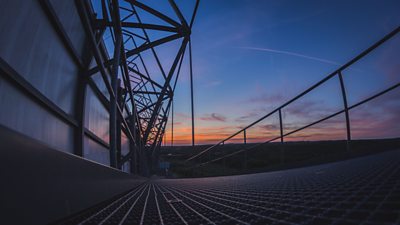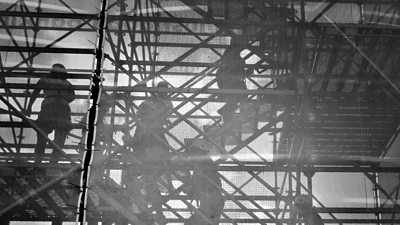The scaffold might be used for a variety of purposes e.g. a camera platform, temporary access or a safety feature for a stunt.
What Can Go Wrong?
- Scaffold collapse
- Falls from height
- Items and equipment falling from height
- Contact with low or sharp parts of the structure i.e. ends of scaffold poles, exposed bolt threads, etc.
- Ladder collapse
- Persons fall from the access ladder
- Bad weather leading to slips, trips or falls from ladders and/or scaffolds.
Legal/���˿��� Requirements
- The Work at Height Regulations apply to all work at height where there is a risk of a fall liable to cause personal injury. They place duties on employers, the self-employed, and any person who controls the work of others (e.g. who may contract others to work at height).
Control Measures
Design and build of scaffold structures
- In the UK, use a scaffolding contractor from the ���˿���’s list of pre-vetted contractors. Liaise with them about the size, nature, use, location, access requirements, ground conditions and likely safe working load for the scaffold structure required – a recce with them may be required. Ensure they are aware of any scrims or weather sheeting you need so they can take account of these in their design calculations for wind-loading.
- For simple / routine scaffold structures (e.g. camera tower on open ground, scaffold around domestic house), typically these will be designed and built by the scaffolding company themselves, under the supervision of an Advanced Scaffolder. However, complex or unusual scaffolds should be purpose-designed, with loading calculations and design drawings signed off by a chartered engineer or scaffold designer, with the scaffold company building to that design. Check which one is being done for you. Please be aware that modular system scaffolding might be used which may introduce limitations on handrail positions and the headroom available.
- Wherever possible, have stairway access with handrails in preference to reliance on inclined ladders.
- Check there will be suitable means for the raising & lowering of equipment to platform level – a rope with hook, equipment bag and block and tackle pulley system is best. Gin wheels may only be used by those competent to do so, because they have no mechanical advantage and you need to know how to tie secure knots around a load using thick rope. You should also know how much weight these haul systems can safely take and never have anyone directly underneath when raising / lowering equipment, including those hauling.
- Obtain a risk assessment / method statement from the scaffolding contractor – check it is specific to the job.
- Arrange a recce with the contractor to discuss the need for lowering the level of edge protection at camera positions, as well as the provision of nets below camera positions should a lens be dropped. Alternatively, camera components can be safety bonded to the main structure.
- All ladders must be of industrial quality, in good condition, rise at an angle of approx. 4:1, be on a secure footing and be secured in place. Ladder ‘runs’ must not be obstructed – especially where the ladder is supported by protruding scaffold poles.
- The ladder must extend above the access point to the scaffold platform by at least 1 metre and a one-way self-closing access gate (or where space is tight, trapdoor) should be fitted at the scaffold access point to maintain complete platform edge protection.
- Ensure that intermediate landings are used wherever a ladder exceeds 9 metres in height.
- Check access around the base of the scaffold platform can be controlled by maintaining a suitable exclusion zone. This could be enforced with boarding, netting, barriers or tape.
- Where security issues may arise, check the scaffold can be secured against unauthorised access e.g. locking gates, removal or boarding of access ladders. Consider using chain and combination locks to prevent access (and avoid the problems of lost keys etc.).
Putting a new scaffold structure into use
- Obtain a sign off or handover certificate from the scaffold company’s competent person which confirms that the scaffolding is ready to use - ensure a scaffolding ticket or tag is placed on the scaffold structure and that it is in-date (see FAQ).
- On handover, conduct a visual check with the contractor to check it meets design specifications. In particular, check access is suitable and that suitable edge protection is provided on all platforms (i.e. tied to structure if not free-standing, complete and level flooring, handrails at approx. 1.1m with mid-rails, kickboards in place, all sharp edges & exposed bolt threads are capped and that there is no sign of the structure leaning).
- The area around access ladders and staircases must be kept clear of obstructions at all times.
- If the scaffold is to be in place for more than a week, agree with the contractor how often it needs to be re-inspected by them for safety. A scaffolder (an Advanced one preferably) should be available to re-inspect it following any adverse weather (e.g. high winds, heavy snow loadings, etc.) or any other event which could affect its stability / safety (e.g. struck by a vehicle, any defects or movement noted by users). In such circumstances, the scaffold should not be used until the scaffolding company have checked it to be safe.
Use of existing scaffold structures
- If not built for the ���˿���, obtain permission to access any scaffolding from the premises owner / manager – they will need to know what access we require and when, including numbers of persons and weight of any equipment and, where necessary, be given time to refer this to the scaffold company.
- Check the scaffold has been safety inspected prior to use - ensure an up to date scaff tag is provided on the scaffold structure (see FAQ). It should be complete, with no exposed drops.
- Our access should be supervised by the scaffold contractor or site manager - access to the platforms should only be via a conventional routes e.g. ladders or stairs.
- A competent person should oversee the loading / lifting of any heavy any equipment onto the scaffold – ideally this person should be from the scaffolding contractor.
- The production team must not move or otherwise modify any of the scaffold structure – if we need any changes made (e.g. to provide better camera angles / access), this must be done by the scaffolding contractor. Do not load the scaffolding beyond agreed levels.
- Store & secure all equipment & personal possessions to prevent them falling onto persons below.
- When using access ladders, maintain three points of contact at all times.
Division Specific Issues
- Incorporating Radio OB MS M015-09 Scaffolding.
FAQs/Did You Know?
- There are two types of scaffolding; suspended and supported. Supported scaffolds are built and designed above their supporting structure (e.g. pipe frame scaffold). Suspended scaffolds are built and designed below their supporting structure (e.g. cantilever scaffold).
- Scaff tags are not strictly a legal requirement, but using a visible tag system to supplement inspection records is one way of recording that the scaffold has been checked before use.
Useful documents
-
[���˿��� Network only]
Recommended links
-
[Gateway]
-
-
Working at Height topics
-

General
Guidance to assist planning, conducting or managing staff who are working at height -

Gantries & High Level Platforms
Guidance on media positions within stadiums and arenas -

Ladders
Guidance on ladders to work up to approx. 6m high -

Ladder Pods
Guidance on ladder pods to work up to 5m high -

Mobile Elevating Work Platforms
Guidance on mobile elevating work platforms (MEWP) such as cherry pickers and scissor lifts. -

Rope Access Techniques
The equipment and techniques required to protect those working at or near exposed drops. -

Ropes Riggers: Selection of
Competence criteria for the various professional Ropes Riggers. -

Tower Scaffolds
Guidance on tower scaffolds to work up to approx 8m high
More from SSR
-
Your platform to record accidents, risk assessments, assurance monitoring and inspections
-
Safety Equipment Stores
Just one number to call: 020 3614 5155 -
���˿��� Safety Guidelines
An A-Z of ���˿���'s Health and Safety Guidelines -
Safety Advice Line: 0370 411 0464 Email: safety@bbc.co.uk
- A-Z of ���˿��� Safety Guidelines
- Accident Reporting and Investigation
- ���˿��� Health & Safety Policy
- Contractors (incl. vetted lists)
- Contributors
- Fire Safety
- Freelancers
- Independent Production Companies
- Risk Assessment
- Safety Alerts
- Safety Responsibilities
- Safety Training
- Sets & Premises Safety Guide
Events guidance - key links:
- Exhibitions
- General Guidance
- Indoor Location Recce Checklist
- Outdoor Location Recce Checklist
- Major Incidents & Emergency Planning
- Marketing and Promotional
- Noise Exposure
- Planning and Management
- Responsibilities
- Responsibilities Form
- Laser Lighting Effects
- Strobe Lighting
- Temporary Stages and Rostra
Health topics - key links:
- (���˿��� network only)
- Contributors Fitness to Participate
- Display Screen Equipment (DSE)
- (���˿��� network only)
- First Aid and Welfare on Location
- International Travel - Risks & Health
- Manual Handling
- Mental Health: ���˿���page
- (���˿��� network only)
- Personal Health and Wellbeing
- Pregnancy
- Psychological Trauma Support & Trauma Risk Management (TRiM)
- Tiredness and Fatigue
- Travel Health Contacts
���˿��� High Risk - key links:
- CBRN and Industrial Spills
- Covert Filming
- Crisis Management and Security Support
- Demonstrations, Protests and Crowds
- Disaster Coverage
- Door Stepping
- (���˿��� network only)
- (���˿��� network only)
- Public Order
- Safety Equipment Stores
���˿��� Journalism - key links:
���˿��� Productions - key links:
- Aerial Filming and Airfields
- Animals: Displaying and handling for performance
- Boats: Working on
- Children and Young People
- Driving
- Electrical Equipment and Systems
- First Aid and Welfare on Location
- Food Safety (Cooking and Catering)
- Remote Location Working
- Roads and Streets: Working by
- Security of Productions on Location
- Stunts
- Tiredness and Fatigue
- Unmanned Aerial Systems (UAS aka Drones)
- Vehicles: Recording in, from and around
- Working at Height: Mobile Elevating Work Platforms
- Working at Height: Tower Scaffolds
���˿��� Radio - key links:
- (���˿��� Network only)
���˿��� Security - key links:
���˿��� Sport - key links:
About this site
This site describes what the ���˿��� does in relation to managing its health, safety and security risks and is intended for those who work directly for the ���˿���.
It is not intended to provide instruction or guidance on how third parties should manage their risks. The ���˿��� cannot be held liable for how this information is interpreted or used by third parties, nor provide any assurance that adopting it would provide any measure of legal compliance. More information
Some links on this site are only accessible when connected to the ���˿��� network

